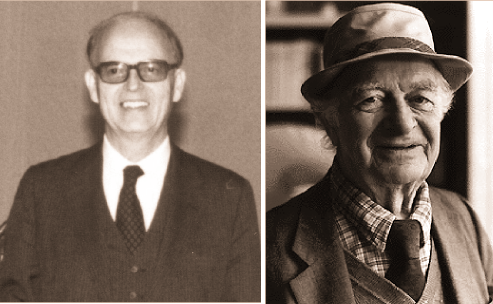It is with the popularization of molecular tools and the disclosure of genome sequences that evolutionary models have become decisive in biology, in part because this information is simply so abundant and so complex that only a comparative method could reveal its meaning.
In 2016, it will be 50 years that Emile Zuckerkandl and Linus Pauling have laid the foundation of molecular phylogeny, and molecular evolution in general, in their seminal article entitled «Molecules as documents of evolutionary history». The fundamental realization of this article was that DNA does not only encode the elementary functional elements of an organisms, it also harbours abundant information on the evolutionary history and life history traits of its ancestors.
The modelling of the evolutionary processes that generated extent genomes should reveal together the patterns of the diversification of life, the processes by which evolution proceeds at the molecular level, and how both are affected by external conditions. Our challenge today, as evolutionary biologists, is to bridge the gap between species ecology, life history traits, population dynamics, species phylogeny, gene phylogeny, genome structure, gene network and molecular mechanisms.
The recent years have seen tremendous developments in this direction, which we will attempt to review in this conference.
Invited speakers
ABBY Sophie (Paris, France)
Evolution playing a molecular building set: origins and distribution of bacterial secretion systems
Evolution playing a molecular building set: origins and distribution of bacterial secretion systems
ACHTMAN Mark (Warwick, United Kingdom)
Ages of bacterial pathogenes
Ages of bacterial pathogenes
ALM Eric (Cambridge, USA)
Driving forces of microbiome evolution
Driving forces of microbiome evolution
DURET Laurent (Lyon, France)
Biased gene conversion as a 4rth evolutionary force
Biased gene conversion as a 4rth evolutionary force
FARIA Nuno (Oxford, United Kingdom)
Viral evolution
Viral evolution
GALTIER Nicolas (Montpellier, France)
Population genomics of non model animals: genetic diversity, adaptive rate and effective population size
Population genomics of non model animals: genetic diversity, adaptive rate and effective population size
GILBERT Thomas (Copenhaguen, Denmark)
Ancient DNA, ancient genomes, and the hype of de-extinction
Ancient DNA, ancient genomes, and the hype of de-extinction
GOGARTEN Peter (Storrs, USA)
Horizontal gene transfer: the pan-genome as shared genetic resource of a lineage
Horizontal gene transfer: the pan-genome as shared genetic resource of a lineage
GRAUR Dan (Houston, USA)
The vocabulary of molecular evolution and the transgressions of functional genomics: a rose by any other name would be misleading
The vocabulary of molecular evolution and the transgressions of functional genomics: a rose by any other name would be misleading
GRIBALDO Simonetta (Paris, France)
Phylogenomics and the tree of life
Phylogenomics and the tree of life
HEATH Tracy (Berkeley, USA)
Molecular, morphological, and macroevolutionary models for dating species divergence times
Molecular, morphological, and macroevolutionary models for dating species divergence times
KATZ Laura (Northampton, USA)
The eukaryotic phylogeny
The eukaryotic phylogeny
KOSIOL Carolin (Vienna, Austria)
Polymorphism-aware phylogenetic models for species trees
Polymorphism-aware phylogenetic models for species trees
LAGERGREN Jens (Stockholm, Sweden)
Generative models of gene family evolution
Generative models of gene family evolution
LỐPEZ-GARCIA Purificación (Orsay, France)
Diversity of microbial life
Diversity of microbial life
McLYSAGHT Aoife (Dublin, Ireland)
Whole genome duplication
Whole genome duplication
MORAN Nancy (Austin, USA)
Symbiosis in evolution
Symbiosis in evolution
PAGEL Mark (Reading, United Kingdom)
Beyond molecular data: information and evolution in the cultural realm
Beyond molecular data: information and evolution in the cultural realm
PHILIPPE Hervé (Moulis, France)
Models of sequence evolution
Models of sequence evolution
SANMARTIN Isabel (Madrid, Spain)
Spatiotemporal evolution of lineages and biotas using Bayesian approaches
Spatiotemporal evolution of lineages and biotas using Bayesian approaches
SEMON Marie (Lyon, France)
Insights into making different types of the same organ using developmental transcriptomes as molecular microscopes
Insights into making different types of the same organ using developmental transcriptomes as molecular microscopes
STADLER Tanja (Zürich, Switzerland)
Modelling and inference of species diversification
Modelling and inference of species diversification
SZÖLLÖSI Gergely (Budapest, Hungary)
Genome scale reconstruction of phylogenies
Genome scale reconstruction of phylogenies
TELFORD Maximilian J. (London, United Kingdom)
The new animal phylogeny
The new animal phylogeny
WARNOW Tandy (Urbana, USA)
New coalescent-based species tree estimation methods
New coalescent-based species tree estimation methods



 http://www.cnrs.fr/insb/cjm/2016/Daubin_e.html
http://www.cnrs.fr/insb/cjm/2016/Daubin_e.html